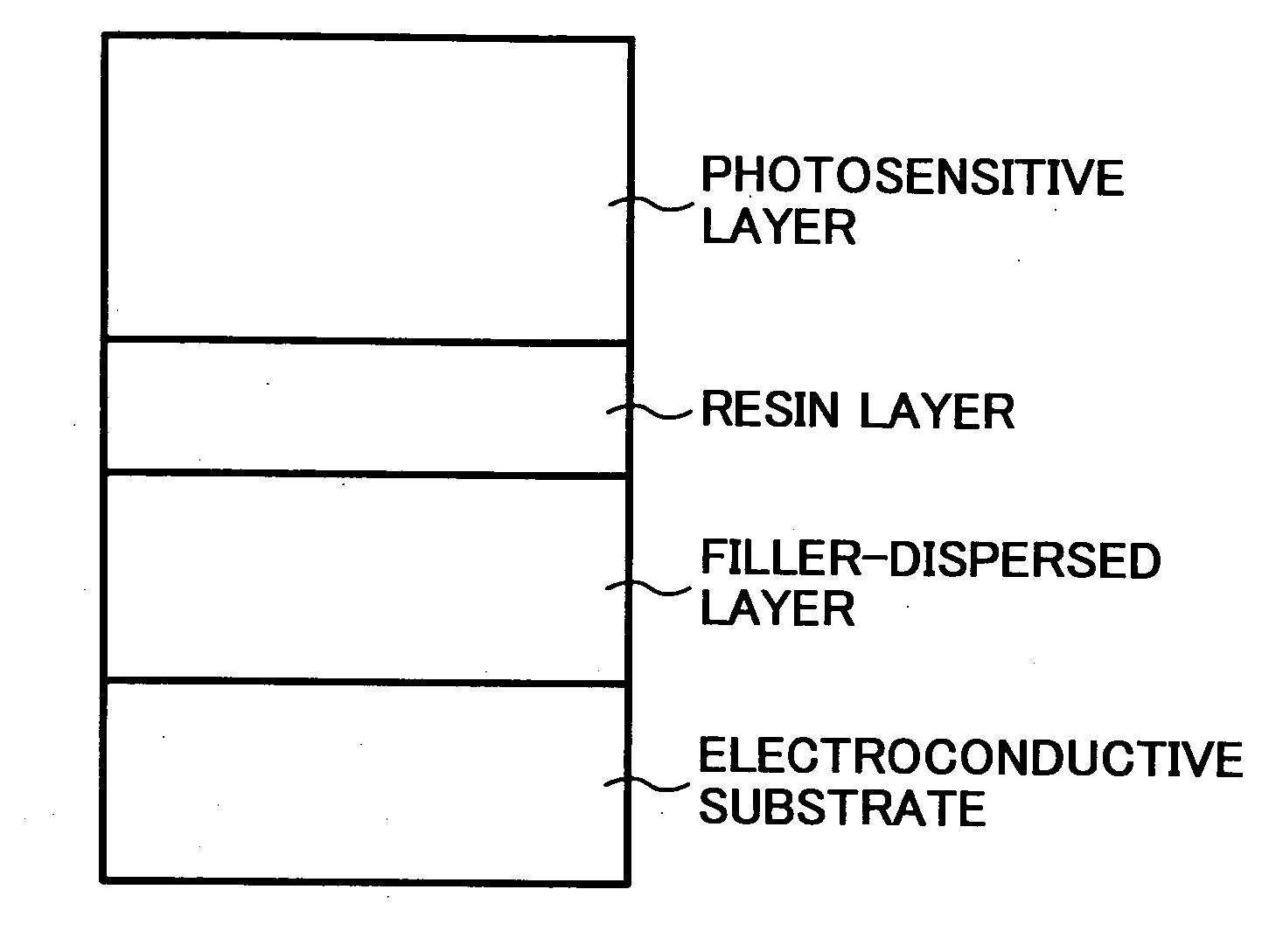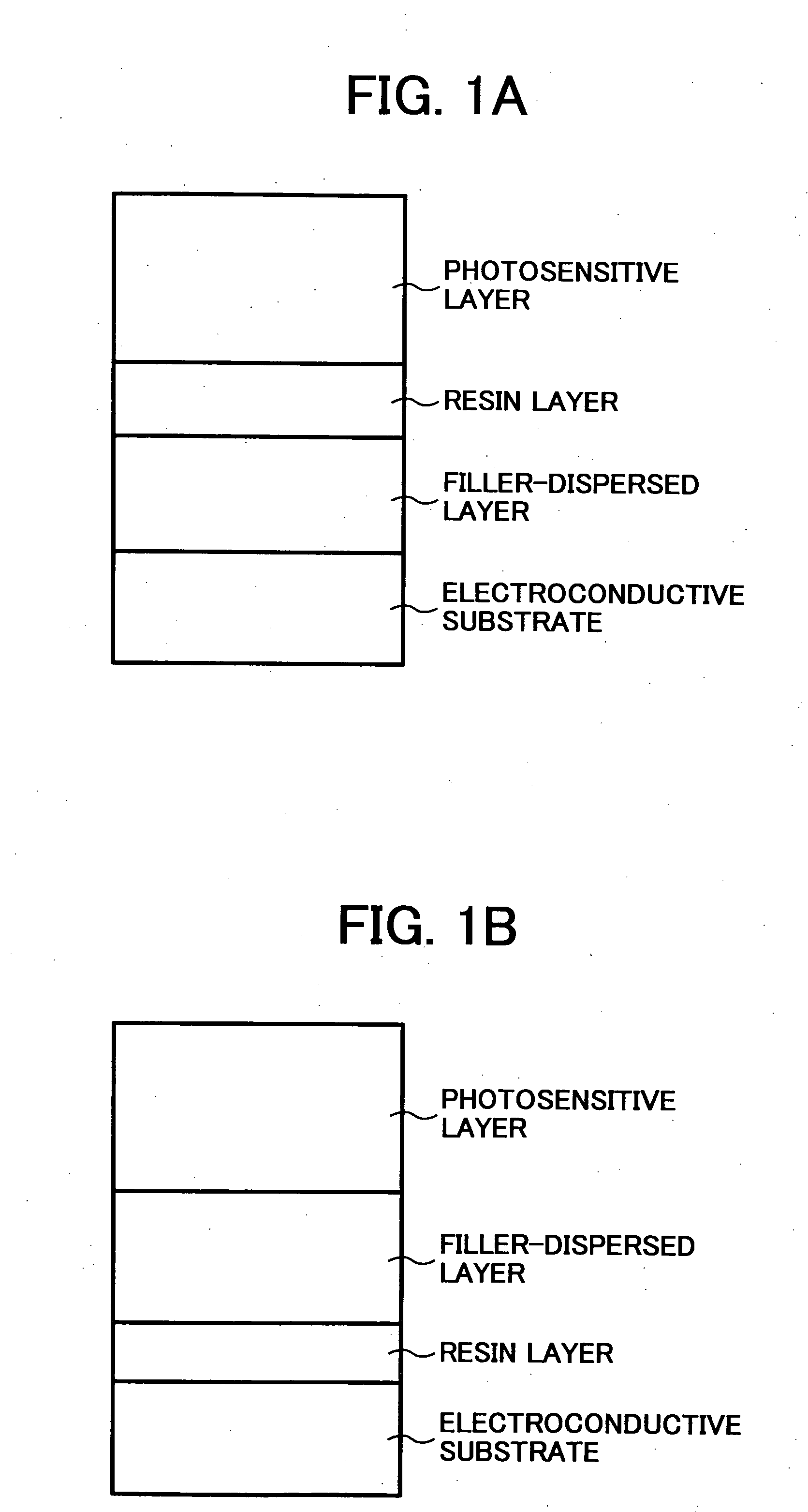Electrophotographic photoreceptor, and image forming apparatus and process cartridge therefor using the electrophotographic photoreceptor
a photoreceptor and electrophotography technology, applied in the field of electrophotographic photoreceptors, can solve the problems of deterioration of image density and image gradation in affecting the quality and requiring replacement, so as to prevent the production of negative and positive images with background fouling and increase residual potential , the effect of high durability and stability
- Summary
- Abstract
- Description
- Claims
- Application Information
AI Technical Summary
Benefits of technology
Problems solved by technology
Method used
Image
Examples
example 1
[0216] An undercoat layer 1 coating liquid 1, an undercoat layer 2 coating liquid, a CGL coating liquid and a CTL coating liquid having the following formulations were coated and dried in this order on an aluminium cylinder having a diameter of 100 mm to prepare an electrophotographic photoreceptor 1 having an undercoat layer 1 0.7 μm thick, an undercoat layer 2 and a CGL of 3.5 μm thick, and a CTL of 28 μm thick. Each layer was dried to the touch after coated, and further dried with heat at 130, 140, 90 and 135° C. respectively.
[0217] Undercoat Layer 1 Coating Liquid
N-methoxymethylated nylon5(FR101 from Namariichi Co., Ltd.)Methanol70n-butanol30
[0218] Undercoat Layer 2 Coating Liquid
Titanium oxide70(CR-EL from Ishihara Sangyo Kaisha, Ltd.,having a purity of 99.7%, an average primaryparticle diameter about 0.25 μm and specificresistivity of 3.5 × 109 Ω· cm)Alkyd resin14(Bekkolite M6401-50 fromDainippon Ink And Chemicals, inc.,having a solid content of 50% anda hydroxyl value of...
example 2
[0222] The procedure for preparation of the electrophotographic photoreceptor 1 in Example 1 was repeated to prepare an electrophotographic photoreceptor 2 except for replacing the undercoat layer 2 coating liquid with a coating liquid having the following formulation.
[0223] Undercoat Layer 2 Coating Liquid
Titanium oxide80(CR-EL from Ishihara Sangyo Kaisha, Ltd.,having a purity of 99.7%, an average primaryparticle diameter about 0.25 μm and specificresistivity of 3.5 × 109 Ω· cm)Alkyd resin12(Bekkolite M6163-60 fromDainippon Ink And Chemicals, inc.,having a solid content of 60% anda hydroxyl value of 70)Block isocyanate resin10(Burnock B3-867 fromDainippon Ink And Chemicals, inc.,having a solid content of 70%)2-butanone100
[0224] The metal oxide to the alkyd resin is about 1.9 / 1 in content ratio. The alkyd resin to the block isocyanate resin is about 1 / 1 in weight ratio.
example 3
[0225] The procedure for preparation of the electrophotographic photoreceptor 1 in Example 1 was repeated to prepare an electrophotographic photoreceptor 3 except for replacing the undercoat layer 2 coating liquid with a coating liquid having the following formulation.
[0226] Undercoat Layer 2 Coating Liquid
Zinc oxide80(SAZEX 2000 fromSAKAI CHEMICAL INDUSTRY CO., LTD.,having a purity of 99.8%, an average primaryparticle diameter about 0.6 μm and specificresistivity of 5.4 × 107 Ω· cm)Alkyd resin20(Bekkolite M6401-50 fromDainippon Ink And Chemicals, inc.,having a solid content of 50% anda hydroxyl value of 130)Block isocyanate resin10(Burnock B7-887-60 fromDainippon Ink And Chemicals, inc.,having a solid content of 60%)2-butanone100
[0227] The metal oxide to the alkyd resin is about 1.3 / 1 in content ratio. The alkyd resin to the block isocyanate resin is about 1.7 / 1 in weight ratio.
PUM
 Login to View More
Login to View More Abstract
Description
Claims
Application Information
 Login to View More
Login to View More - R&D
- Intellectual Property
- Life Sciences
- Materials
- Tech Scout
- Unparalleled Data Quality
- Higher Quality Content
- 60% Fewer Hallucinations
Browse by: Latest US Patents, China's latest patents, Technical Efficacy Thesaurus, Application Domain, Technology Topic, Popular Technical Reports.
© 2025 PatSnap. All rights reserved.Legal|Privacy policy|Modern Slavery Act Transparency Statement|Sitemap|About US| Contact US: help@patsnap.com



